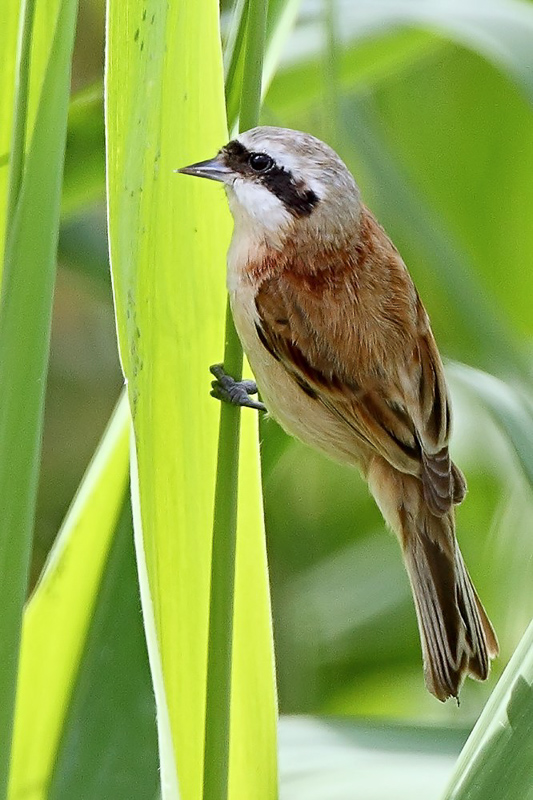Chinese Penduline Tit Remiz consobrinus 中華攀雀
Category I. Common winter visitor to reed marsh in the Deep Bay area; scarce migrant through wetlands elsewhere.
IDENTIFICATION

Mar. 2012, Michelle and Peter Wong. Male.
9-12 cm. Small with conical pointed bill mostly pale. Adult male has distinct whitish-bordered black mask extending from forehead to well behind eye, pale grey crown and nape, brown upperparts with rusty band across top of mantle, buff edges to secondaries and tertials and pale creamy throat and chest becoming buff on belly and warmer on flanks.

Apr. 2012, Martin Hale. Female.
Female has less distinct brown mask, pale buff-brown upperparts and sandy to buff underparts. First-winter birds have poorly-marked mask and are plainer.
VOCALISATIONS
The commonly heard vocalisation from both foraging birds and those in flight is a high-pitched ‘sseeeoo’ or ‘seeeee’ that descends sharply in pitch.
The song is similar to the call but is longer and more drawn out, occasionally with a step in the frequency decline.
DISTRIBUTION & HABITAT PREFERENCE
Most records are of flocks in the reed beds in the Deep Bay area, especially at Mai Po. However, there have been reports from around Starling Inlet (including up to 30 at Kuk Po), Lam Tsuen, Lantau, including Chek Lap Kok, and Shuen Wan/Ting Kok. At Long Valley it is occasionally reported, mainly in autumn, with 28 on 18 March being the highest count.
OCCURRENCE
Chinese Penduline Tit was first recorded in HK on 20 April 1981 (Chalmers 1984), when a party of three birds was seen at Mai Po; since 1989, however, it has been a regular passage migrant and winter visitor.
The earliest record in autumn is of one trapped on 26 October 2009, but autumn numbers peak in mid to late November. The highest count is an estimated 200 at Mai Po NR on 19 November 2013, but this count is exceptional and more typical counts are of up to 70 birds. Most birds appear to pass through by mid-December but small numbers remain throughout the winter. Spring passage commences in early March and the largest numbers are usually present in early April; counts are smaller than in autumn, with the highest being 73 on 19 March 2016 and 70 on 12 April 2004. The latest record occurred on 23 May 2008.
Figure 1, which is based on constant effort trapping data, illustrates the pattern of occurrence during the year in the reedbeds at Mai Po NR. These data suggest that the pattern of sight records discussed above is indeed an accurate representation of the relative numbers present at different times of year. However, detailed analysis of the ringing data shows the actual number of individuals that pass through HK in the course of the winter is much higher than either the sight records or the numbers of individuals caught might suggest.
Thus, whilst 304 birds have been trapped in HK, only eleven of these were recaptured; this very low (<4%) recapture rate suggests that the number of birds trapped is only a small percentage of the numbers present. Furthermore, whilst only eleven birds have been recaptured, three of these recaptures occurred in winter seasons subsequent to those in which they were first trapped. This 27% inter-season recapture rate is of interest in itself as it suggests a high degree of site fidelity, but, in addition, it shows that there is a high turnover of birds within a season (otherwise the same-season recapture rate would be higher relative to the inter-season recapture rate).
When this species was first recorded in HK it was not known to occur in eastern China any further south than the Chang Jiang (Yangtze River). However, as noted above, in parallel with the increase in numbers recorded, it has become much commoner on passage through Hebei, China (Williams 1986, 2000) and in winter in Japan (Brazil 1991). Birds passing through HK appear to spend the winter in southwest China and north Vietnam, but probably elsewhere, as there are relatively few records south of HK based on eBird.
BEHAVIOUR, FORAGING & DIET
Forages mainly in Phragmites reed beds, where it is presumed to feed on insects inside the reed stems. A flock present in a field of Chinese Kale Brassica alboglabra that had been allowed to go to seed at Long Valley during April 1996 is the only observation of birds foraging in another habitat.
Typically recorded in loose flocks foraging in or flying over reeds, groups may take flight with no obvious cause. Birds may be rather hard to see in extensive reed beds, especially on windy days, but the call is distinctive. Migrating parties are most often detected early morning flying over Mai Po NR or fish pond areas.
RANGE & SYSTEMATICS
Monotypic. Breeds from Ussuriland southwest through northeast China and east Nei Mongol to south Ningxia; winters in South Korea, southern Japan and in China along the coast and Yangtze floodplain, locally along the south coast and in the southwest (Madge 2020, Liu and Chen 2020).
CONSERVATION STATUS
IUCN: Least Concern. Population trend increasing.
Figure 1.

Chalmers, M.L. (1984). Report on the birds 1981. Hong Kong Bird Report 1981/82: 5-46.
Liu, Y. and Y. H. Chen (eds) (2020). The CNG Field Guide to the Birds of China (in Chinese). Hunan Science and Technology Publication House, Changsha.
Madge, S. (2020). Chinese Penduline-Tit (Remiz consobrinus), version 1.0. In Birds of the World (J. del Hoyo, A. Elliott, J. Sargatal, D. A. Christie, and E. de Juana, Editors). Cornell Lab of Ornithology, Ithaca, NY, USA. https://doi.org/10.2173/bow.chptit1.01

